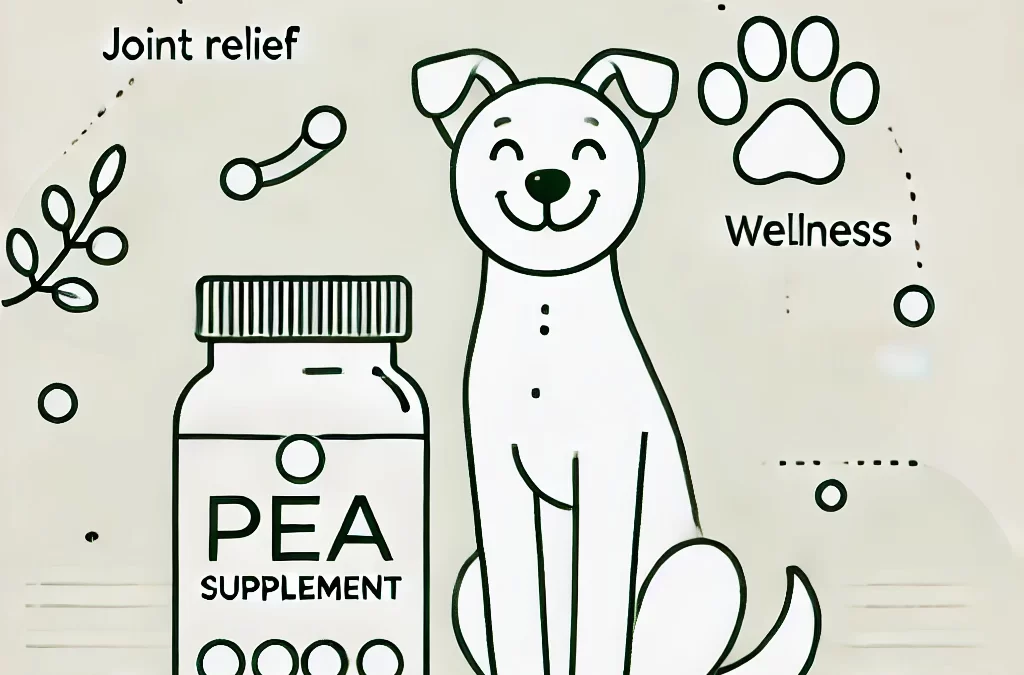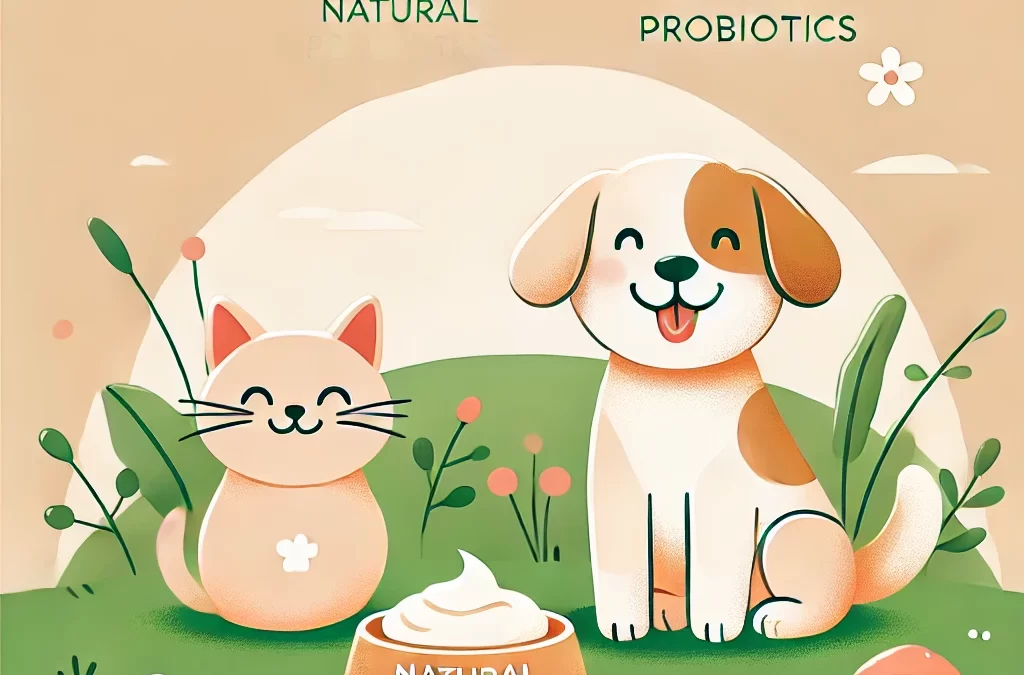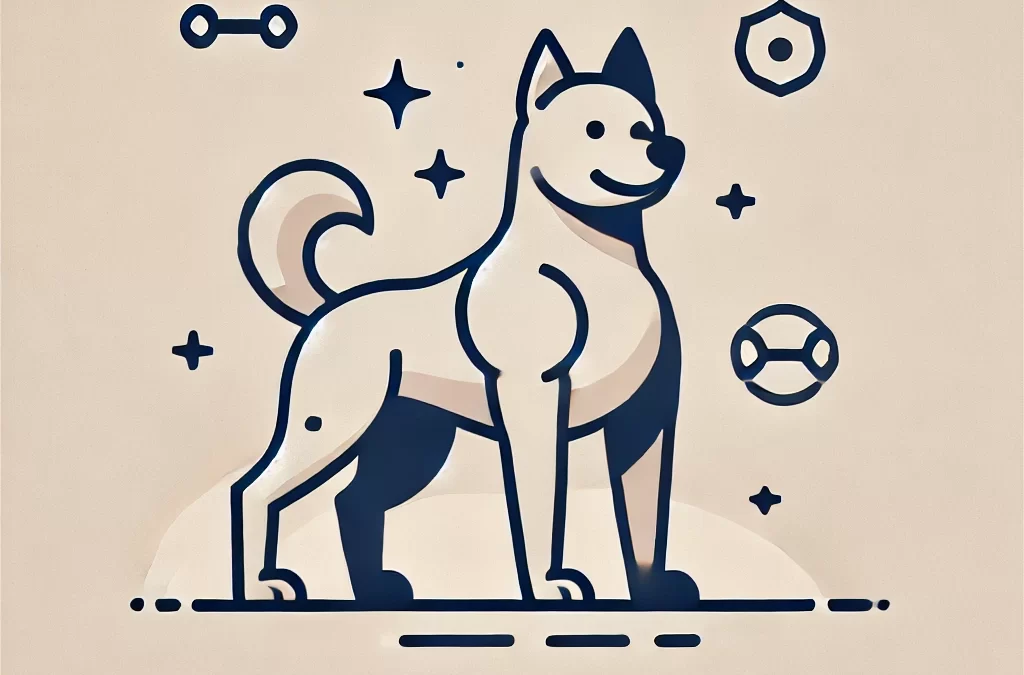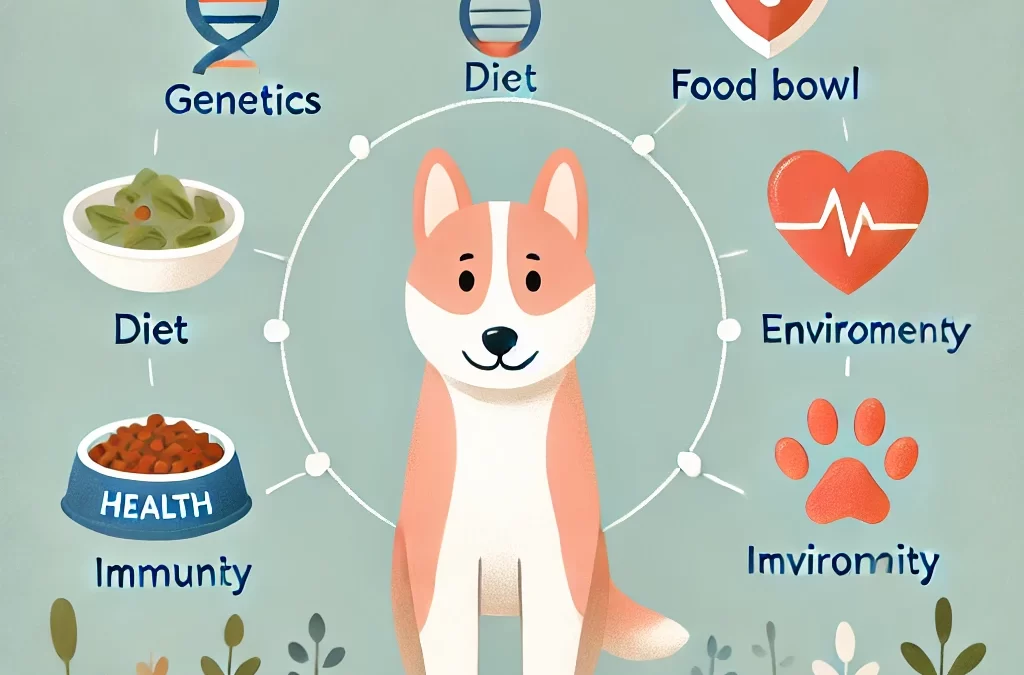
por TCMVET | 13 de noviembre de 2024 | Alimentación y salud
La palmitoiletanolamida, o PEA, está ganando popularidad en el mundo del cuidado canino por sus propiedades analgésicas y antiinflamatorias naturales. Descubierta originalmente como una amida de ácido graso producida por el cuerpo, la PEA es un compuesto similar a los endocannabinoides que se encuentra en varios tejidos, incluidos el cerebro y el sistema inmunológico. Este compuesto único, presente en alimentos como los huevos y la soja, ha demostrado tener posibles beneficios para ayudar a controlar el dolor y reducir la inflamación tanto en humanos como en animales. Pero, ¿qué significa para nuestros compañeros caninos?
¿Qué es la PEA y por qué es útil para los perros?
La PEA se produce de forma natural en el organismo de los humanos y de los perros como respuesta a la inflamación y el dolor. Como compuesto endógeno, la PEA trabaja con el sistema endocannabinoide para ayudar a modular la inflamación y la percepción del dolor sin efectos psicoactivos. Esto la convierte en una alternativa más segura para las mascotas en comparación con los productos farmacéuticos tradicionales, especialmente para el uso a largo plazo.
Beneficios clave de la PEA para perros:
- Alivio del dolor: La PEA interactúa con los receptores del sistema nervioso, proporcionando un medio natural para reducir el malestar.
- Propiedades anti-inflamatorias: Actúa sobre la respuesta inmunitaria del cuerpo para disminuir la inflamación, lo que puede beneficiar a los perros que sufren de artritis, dermatitis y otras afecciones inflamatorias.
- Improved Quality of Life: Al aliviar el dolor y la inflamación, la PEA puede mejorar la movilidad, los niveles de energía y el bienestar general.
¿Cómo funciona la PEA?
A diferencia de otros analgésicos, la PEA no bloquea las señales de dolor directamente. En cambio, actúa sobre lo que se conoce como el “efecto séquito”, que mejora los procesos naturales que regulan el dolor y la inflamación. A continuación, se muestra una descripción simplificada de cómo funciona:
- Interacción con los receptores cannabinoides:La PEA interactúa indirectamente con los receptores cannabinoides (receptores CB2) en el sistema inmunológico, promoviendo una respuesta inmune equilibrada.
- Inhibición de enzimas inflamatorias:Inhibe las enzimas que alimentan la inflamación, permitiendo que los procesos de curación naturales del cuerpo funcionen de manera más efectiva.
- Estabilización de mastocitos:La PEA estabiliza los mastocitos, que son células inmunes que liberan histaminas en respuesta a una lesión o inflamación, lo que reduce el malestar relacionado con la inflamación.
¿Qué afecciones puede ayudar a controlar la PEA en los perros?
La PEA puede beneficiar a los perros con una variedad de enfermedades crónicas:
- Artritis:Sus efectos antiinflamatorios pueden ayudar a los perros con inflamación y rigidez en las articulaciones.
- Skin Conditions:Los perros con dermatitis crónica pueden experimentar alivio de la picazón y la irritación.
- Afecciones neurológicas:Algunas investigaciones sugieren que la PEA puede ayudar a los perros con dolor relacionado con los nervios al calmar las células nerviosas hiperactivas.
- Recuperación posquirúrgica:Las propiedades analgésicas de la PEA pueden favorecer una recuperación más rápida y el control del dolor después de una cirugía.
Uso seguro de PEA: dosis y precauciones
La PEA generalmente se tolera bien, pero es esencial seguir un enfoque seguro:
- Consulte a un veterinario:Siempre hable con un veterinario antes de introducir PEA en la rutina de su perro, especialmente si está tomando otros medicamentos.
- Comience lentamente:Introduzca la PEA en dosis más pequeñas y controle la aparición de reacciones. La PEA suele estar disponible en comprimidos, polvo o formas masticables, y las recomendaciones de dosis se basan en el peso corporal.
- Observar y ajustar:Controle la respuesta de su perro, ajustando la dosis según sea necesario bajo supervisión veterinaria.
Cómo elegir el suplemento de PEA adecuado para su perro
No todos los suplementos de PEA son iguales. Al seleccionar un producto de PEA, busque:
- Pureza y calidad:Elija suplementos cuya pureza esté probada y libres de contaminantes.
- Forma micronizada:Esta forma de PEA es más biodisponible, lo que significa que se absorbe de manera más efectiva en el sistema de su perro.
- Productos específicos para perros:Algunas marcas diseñan PEA específicamente para mascotas, garantizando la dosis y formulación correctas.
Reflexiones finales: El futuro de la PEA en el cuidado de mascotas
A medida que más dueños de mascotas buscan opciones naturales para mejorar la vida de sus perros, la PEA se destaca como una incorporación prometedora. Su enfoque multifacético para aliviar el dolor y controlar la inflamación puede beneficiar a las mascotas mayores, a aquellas con enfermedades crónicas y a cualquier perro que necesite un apoyo seguro y suave para su bienestar.
Con la creciente investigación y fórmulas más específicas para mascotas, la PEA pronto podría convertirse en un producto básico en el cuidado holístico de las mascotas. Sus mecanismos únicos y su seguridad comprobada la convierten en una opción viable e innovadora para favorecer la comodidad y la vitalidad de los perros sin los efectos secundarios de los medicamentos convencionales.

por TCMVET | 13 de noviembre de 2024 | Alimentación y salud
Al igual que los humanos, las mascotas pueden beneficiarse enormemente de los probióticos, las "bacterias buenas" que favorecen la salud intestinal, la inmunidad y el bienestar general. Si bien los probióticos comerciales son populares, las fuentes naturales de probióticos están surgiendo como un enfoque eficaz y holístico. Este artículo analiza en profundidad qué son los probióticos naturales, dónde se pueden encontrar y cómo pueden mejorar la salud de su mascota de forma natural.
1. ¿Qué son los probióticos naturales para las mascotas?
- DefiniciónLos probióticos naturales son bacterias beneficiosas vivas que se encuentran en alimentos, hierbas y plantas fermentadas naturalmente.
- Cómo funcionan:Estos microorganismos ayudan a equilibrar el microbioma intestinal, mejoran la digestión, mejoran la respuesta inmune e incluso pueden tener un impacto positivo en el estado de ánimo.
- Diferencias con los probióticos comercialesLos probióticos naturales provienen de alimentos integrales y están menos procesados, lo que ofrece una solución más cercana a la naturaleza.
2. Beneficios de los probióticos naturales para las mascotas:
- Mejor digestión:Los probióticos pueden ayudar a descomponer los alimentos, absorber nutrientes y reducir problemas digestivos como gases o diarrea.
- Inmunidad más fuerte:Un microbioma intestinal equilibrado fortalece el sistema inmunológico, ayudando a las mascotas a combatir las infecciones de manera más efectiva.
- Alivio de las alergias:La ingesta regular de probióticos puede aliviar las alergias de la piel al reducir la inflamación en el intestino, donde se originan muchas respuestas inmunes.
- Estado de ánimo y comportamiento:Las investigaciones muestran una conexión entre la salud intestinal y el estado de ánimo, lo que sugiere que los probióticos pueden tener un efecto calmante en las mascotas.
3. Fuentes de probióticos naturales para mascotas:
- Yogur y kéfir:El yogur natural sin azúcar y el kéfir son ricos en probióticos como Lactobacillus acidophilus y BifidobacteriaEstos pueden favorecer la salud digestiva si se administran en cantidades pequeñas y seguras.
- Verduras fermentadas:Pequeñas cantidades de verduras fermentadas como el chucrut (sin sal) pueden ofrecer probióticos, pero deben introducirse con precaución.
- Vinagre de sidra de manzanaEl vinagre de sidra de manzana crudo contiene enzimas y bacterias beneficiosas, pero debe diluirse antes de su uso para evitar malestar digestivo.
- Hierbas y organismos del suelo:Algunas hierbas como la raíz de diente de león y la raíz de achicoria contienen prebióticos, que nutren las bacterias beneficiosas. Además, los probióticos de origen vegetal que se encuentran en la tierra orgánica apta para mascotas pueden favorecer la salud intestinal de forma natural.
4. Cómo introducir probióticos naturales en la dieta de tu mascota
- Empieza pequeño:Introduzca pequeñas cantidades y controle cualquier malestar o reacción digestiva.
- Observar y ajustar:Si su mascota parece beneficiarse, aumente gradualmente la frecuencia o la cantidad según lo recomendado por un veterinario.
- La consistencia es la claveLas dosis regulares y constantes de probióticos naturales tienden a producir los mejores resultados, así que busque un método que funcione con la rutina diaria de su mascota.
5. Cuándo considerar los probióticos naturales en lugar de los suplementos
- Para mascotas sensibles:Las mascotas que no toleran bien los suplementos probióticos comerciales podrían responder mejor a fuentes naturales.
- Tratamiento post antibiótico:Después de una ronda de antibióticos, los probióticos naturales pueden ayudar a restaurar el microbioma intestinal.
- Mantenimiento diario de la salud:Si busca un enfoque preventivo, los probióticos naturales pueden ser una opción suave y eficaz para la salud diaria.
6. Consejos de seguridad y aspectos a tener en cuenta
- Evite los aditivos:Limítese a fuentes probióticas simples, sin sabor y sin azúcar, ya que los aditivos como el azúcar y los sabores artificiales pueden dañar a las mascotas.
- Consult Your Vet:Siempre consulte con su veterinario, especialmente si su mascota tiene algún problema de salud subyacente o alergias.
- Monitorear los efectos secundarios:En casos raros, las mascotas pueden experimentar diarrea leve o hinchazón mientras sus sistemas se adaptan a los nuevos probióticos.
Conclusión:
Los probióticos naturales ofrecen una forma holística de mejorar la salud de su mascota, ya que favorecen la digestión, la inmunidad e incluso el estado de ánimo. Al introducir fuentes seguras y naturales de probióticos, le está proporcionando un camino más natural hacia el bienestar. Con paciencia y constancia, estos ayudantes naturales pueden convertirse en una parte esencial de la rutina de su mascota para que tenga una vida más feliz y saludable.

por TCMVET | 13 de noviembre de 2024 | Cáncer y tumores en perros
Los bultos de grasa, o lipomas, son uno de los crecimientos no cancerosos más comunes en los perros, en particular a medida que envejecen. Los dueños de mascotas suelen sentirse alarmados cuando descubren estos bultos, pero la mayoría de los lipomas son benignos. En este artículo, exploraremos cómo se sienten estos bultos, cómo distinguirlos de otros crecimientos y consejos sobre cuándo consultar a un veterinario.
1. ¿Qué son los bultos de grasa?
- Definición de Lipomas:Los lipomas son depósitos blandos y grasos que se forman debajo de la piel, generalmente en perros mayores o con sobrepeso.
- Ubicaciones comunes:Generalmente se encuentra en el torso, las axilas y las extremidades, pero puede aparecer en varias ubicaciones.
- CausaAunque las causas exactas no se conocen por completo, pueden estar relacionadas con la edad, la raza, la genética y el peso.
2. La sensación de los bultos de grasa:
- Suave y movible:Los lipomas son generalmente blandos y ligeramente blandos, y se sienten como un bulto de masa debajo de la piel. Son fáciles de mover con un empujón suave, lo que a menudo los diferencia de los crecimientos más duros y menos móviles.
- No es doloroso:A diferencia de los quistes o abscesos, los lipomas no son dolorosos a menos que presionen un nervio o una articulación.
- Textura consistente:Los lipomas suelen tener la misma textura en toda su extensión, con una textura homogénea y pastosa.
3. Diferencias entre los lipomas y otros tipos de bultos:
- Cysts:Los quistes, a menudo más firmes, pueden estar llenos de líquido y a veces tienen un punto central, a diferencia de la uniformidad de un lipoma.
- Abscesos:Suelen ser dolorosas y estar calientes al tacto, a menudo acompañadas de enrojecimiento.
- Crecimientos cancerosos:Los bultos malignos pueden ser más duros al tacto, suelen estar fijos en un lugar y pueden crecer rápidamente o de manera irregular. Los tumores pueden tener una forma irregular o ser firmes al tacto.
- Fibromas:Estos tumores benignos se sienten más firmes que los lipomas y son menos móviles, pero generalmente son inofensivos.
4. ¿Cuándo debería preocuparse?
- Índice de crecimiento:Si un bulto crece rápidamente, cambia de forma o se vuelve doloroso, es mejor consultar a un veterinario de inmediato.
- Preocupaciones sobre la ubicación:Los bultos cerca de las articulaciones o en áreas que afectan la movilidad pueden requerir extracción o control.
- Múltiples bultos:Los lipomas múltiples son comunes en algunas razas, pero si aparecen nuevos bultos rápidamente, considere un control veterinario.
5. Diagnóstico de los lipomas:
- Examen veterinario:Un veterinario puede confirmar si un bulto es un lipoma mediante palpación.
- Aspiración con aguja fina (FNA):Para un diagnóstico más definitivo, la PAAF puede recolectar células del bulto para su análisis, lo que brinda claridad sobre si el bulto es benigno o requiere más investigación.
6. ¿Deben eliminarse los lipomas?
- Cuando es necesaria la cirugía:Por lo general, los lipomas se dejan intactos a menos que causen molestias, restrinjan el movimiento o crezcan excesivamente.
- Opciones mínimamente invasivas:Los métodos más nuevos, como la liposucción o las inyecciones de esteroides, pueden ayudar a reducir los lipomas en algunos casos.
7. Prevención y consejos de salud para reducir los lipomas:
- Mantener un peso saludable:La obesidad es un factor de riesgo conocido para los lipomas.
- Revisiones regulares:Las visitas regulares al veterinario permiten la detección temprana y el seguimiento de cualquier nuevo crecimiento.
- Dieta equilibrada y ejercicio:Una dieta equilibrada y ejercicio constante pueden ayudar a prevenir la obesidad, lo que puede reducir la probabilidad de padecer lipomas.
Conclusión: Si bien los bultos de grasa en los perros pueden ser preocupantes, a menudo son inofensivos y fáciles de controlar. Al comprender la sensación, las causas y los síntomas de los lipomas, los dueños de perros pueden tomar decisiones informadas sobre la salud de su mascota. Si no está seguro acerca de un bulto en su perro, siempre busque asesoramiento profesional para su tranquilidad.

por TCMVET | 12 de noviembre de 2024 | Cáncer y tumores en perros
Para los dueños de mascotas que buscan ayudar a sus perros a desarrollar masa muscular magra, mejorar su fuerza o recuperarse de una lesión, la idea de los suplementos para el desarrollo muscular puede parecer intrigante. Si bien no son un estándar para todos los perros, estos suplementos pueden beneficiar a ciertas razas, perros con mucha energía, perros de trabajo e incluso a aquellos en recuperación. Aquí, exploraremos los beneficios de los suplementos para el desarrollo muscular para perros, los ingredientes clave que se deben buscar y consejos para elegir productos seguros y efectivos.
1. Por qué los músculos son importantes para los perros
Un sistema muscular sano es vital para todos los perros, no solo para los activos o atléticos. Los músculos ayudan a sostener las articulaciones, mejoran la resistencia y mantienen la movilidad general. En el caso de los perros que participan en actividades de agilidad, caza u otras actividades de alta intensidad, unos músculos fuertes pueden ayudar a prevenir lesiones y mejorar el rendimiento. Además, los perros mayores, los que se están recuperando de una cirugía y los perros con determinadas afecciones, como la artritis, pueden beneficiarse del apoyo muscular para mantener la fuerza y reducir las molestias.
2. ¿Quién debería considerar tomar suplementos para desarrollar músculos?
Los suplementos para desarrollar los músculos no son necesarios para todos los perros, pero pueden ser beneficiosos para:
- Razas activas: Razas como los Border Collies, los Pastores Alemanes y los Labradores que son naturalmente energéticos y prosperan con una rutina de ejercicio estructurada.
- Perros de trabajo: Los perros policiales, militares y de servicio a menudo requieren capacidades físicas mejoradas.
- Perros mayores: Los perros que envejecen pueden perder masa muscular con el tiempo. Los suplementos pueden ayudar a mantener el tono muscular, lo que favorece la salud de las articulaciones.
- Perros en recuperación: Los perros que se recuperan de una cirugía o lesión pueden necesitar apoyo adicional para recuperar fuerza y movilidad.
3. Ingredientes clave que se deben buscar
No todos los suplementos para el desarrollo muscular son iguales, por lo que conocer los beneficios de los ingredientes puede ayudar a seleccionar un producto de calidad. Estos son los principales ingredientes que pueden favorecer la salud muscular:
- Aminoácidos: Los componentes básicos de las proteínas, como la L-carnitina y la L-glutamina, contribuyen al desarrollo y la recuperación muscular. Son fundamentales para que los perros desarrollen o mantengan masa muscular magra.
- Creatina: Aunque suele asociarse con el culturismo humano, la creatina es un compuesto natural que puede ayudar a los perros a mejorar el rendimiento muscular. Es especialmente beneficiosa para momentos de energía breves, como el sprint o el entrenamiento de agilidad.
- Ácidos grasos omega-3: Se sabe que estas grasas saludables reducen la inflamación, lo que puede ayudar a la recuperación después del ejercicio. Los omega-3 también pueden favorecer la salud de las articulaciones, lo que los convierte en un buen complemento para un suplemento centrado en los músculos.
- Fuentes de proteínas: Las fuentes de proteínas de alta calidad, como el pollo, el pescado o la carne de res, aportan nutrientes esenciales para el crecimiento y la reparación de los músculos. Algunos suplementos para el desarrollo muscular incorporan proteína deshidratada en polvo.
- Compuestos para el soporte de las articulaciones: Ingredientes como la glucosamina y la condroitina no ayudan directamente al desarrollo muscular, pero favorecen la salud de las articulaciones, algo vital para los perros activos que quieren desarrollar y mantener sus músculos.
4. Cómo elegir el suplemento adecuado para desarrollar los músculos
Al seleccionar un suplemento, tenga en cuenta estos consejos para asegurarse de proporcionar el producto más seguro y eficaz para su perro:
- Elija productos específicos para perros: Algunos suplementos para el desarrollo muscular de los perros pueden ser perjudiciales para ellos. Busque productos específicamente formulados para la fisiología canina.
- Compruebe que los ingredientes sean de alta calidad: Cuanto menos rellenos, sabores artificiales o conservantes contenga, mejor. Un buen suplemento debe ser rico en ingredientes integrales.
- Hable con su veterinario: Antes de comenzar a administrar cualquier suplemento, consulte con su veterinario, especialmente si su perro tiene alguna condición de salud preexistente.
- Comience lentamente: Introduzca gradualmente cualquier suplemento nuevo para observar cómo responde su perro y evite darle más de la dosis recomendada.
5. Suplementación vs. Dieta natural
Si bien los suplementos pueden ser una forma conveniente de mejorar la salud muscular de su perro, una dieta equilibrada es fundamental. Las dietas ricas en proteínas, que incluyen carnes magras, huevos y algo de pescado, pueden favorecer naturalmente la salud muscular. Los suplementos son más eficaces cuando se combinan con una buena nutrición y una rutina de ejercicios adecuada.
6. Desarrollar músculos mediante ejercicios y entrenamiento
Los suplementos por sí solos no pueden desarrollar los músculos; es esencial una rutina de ejercicios bien estructurada. Concéntrese en actividades que involucren a todo el cuerpo, como:
- Caminatas o senderismo con peso: Colocar una mochila ligera puede proporcionar una resistencia suave para perros sanos.
- Entrenamiento de agilidad: Fomenta la flexibilidad y desarrolla la fuerza mientras mantiene a tu perro mentalmente estimulado.
- Nadar: La natación es un ejercicio de bajo impacto y es excelente para el crecimiento muscular y la salud de las articulaciones.
Conclusión: Cómo construir un perro más fuerte y más sano
Los suplementos para el desarrollo muscular pueden ser un complemento valioso para los perros que necesitan un refuerzo de fuerza, pero funcionan mejor cuando se combinan con una nutrición equilibrada y ejercicio. Si elige cuidadosamente suplementos de alta calidad y mantiene informado a su veterinario, podrá contribuir a la salud muscular de su perro y garantizar que se mantenga activo, fuerte y preparado para las aventuras de la vida.

por TCMVET | 12 de noviembre de 2024 | Cáncer y tumores en perros
El cáncer es una de las enfermedades más desafiantes tanto para los humanos como para las mascotas, y es particularmente desgarrador cuando afecta a nuestros amados perros. Pero comprender por qué y cómo se desarrolla el cáncer en los perros puede arrojar luz sobre la prevención y brindar información para la detección temprana. Si bien no existe una forma infalible de prevenir el cáncer, exploremos los principales factores que contribuyen, las investigaciones emergentes y las formas en que podemos ayudar a reducir los riesgos.
1. Genética: la influencia de la raza y la historia familiar
Algunas razas tienen una mayor predisposición al cáncer. Por ejemplo, razas como los golden retriever, los bóxers y los rottweilers tienen una tendencia genética a desarrollar ciertos tipos de cáncer. Las investigaciones sugieren que las mutaciones genéticas heredadas desempeñan un papel importante en estas tendencias. Un estudio publicado en Genética y epidemiología canina Se ha descubierto que determinadas razas comparten rasgos genéticos que las hacen más susceptibles a los tumores. Como resultado, el linaje de un perro puede aumentar su riesgo, lo que significa que los dueños de mascotas de determinadas razas deben estar más atentos y realizar controles veterinarios regulares.
2. Factores ambientales: carcinógenos y toxinas cotidianas
Los perros están expuestos a toxinas ambientales al igual que los humanos. Los culpables más comunes incluyen el humo de segunda mano, ciertos productos de limpieza, pesticidas y la contaminación. Los perros, al estar en estrecho contacto con pisos y superficies exteriores, pueden ingerir o inhalar fácilmente sustancias nocivas, introduciendo toxinas en sus cuerpos sin saberlo. También hay evidencia creciente que muestra una correlación directa entre la exposición a carcinógenos específicos y un mayor riesgo de cáncer en los perros.
Información procesable: Para minimizar la exposición, considere elegir productos de limpieza naturales, evitar fumar cerca de las mascotas y asegurarse de que las áreas de juego de su perro estén libres de pesticidas.
3. Dieta: el papel de la nutrición en la prevención del cáncer
Lo que come un perro puede tener efectos profundos en su salud, influyendo en todo, desde la función inmunológica hasta la salud celular. Un alimento de mala calidad, con un alto contenido de rellenos y aditivos artificiales, puede contribuir a mutaciones celulares e inflamación, lo que puede derivar en cáncer. Por otro lado, una dieta equilibrada rica en antioxidantes, ácidos grasos omega y proteínas naturales puede favorecer la reparación celular y las defensas inmunológicas.
Recomendación dietética: Considere cambiar a comidas de alta calidad, orgánicas o incluso caseras, adaptadas a las necesidades nutricionales de su perro. Siempre consulte con un veterinario para obtener orientación sobre la mejor dieta.
4. Influencias hormonales y salud reproductiva
Las hormonas son poderosos mensajeros químicos en el cuerpo y pueden influir en el crecimiento de los tumores. Los estudios han demostrado que la esterilización o castración a la edad adecuada puede reducir el riesgo de ciertos tipos de cáncer, como el cáncer de mama o el cáncer de testículo. Sin embargo, el momento de realizar estos procedimientos es esencial, ya que la esterilización o castración temprana se ha relacionado con un mayor riesgo de otros tipos de cáncer, como el osteosarcoma.
Decisión equilibrada: Hable con su veterinario sobre el mejor momento para esterilizar a su perro, ya que el momento puede variar según la raza y la salud individual.
5. Infecciones y virus
Se sabe que ciertas infecciones y virus son cancerígenos. En los perros, los virus como el virus del papiloma canino pueden causar verrugas que pueden convertirse en tumores malignos en casos excepcionales. Además, las infecciones que causan inflamación crónica pueden provocar cambios y mutaciones celulares con el tiempo, lo que puede derivar en cáncer.
6. El envejecimiento: un factor inevitable
La edad es uno de los factores de riesgo más importantes para el cáncer en los perros. Con las mejoras en la atención veterinaria, los perros viven más tiempo y, con la edad, aumenta la probabilidad de padecer cáncer. A medida que las células de un perro envejecen, los mecanismos para reparar los daños en el ADN pueden volverse menos eficientes, lo que facilita la aparición de mutaciones cancerosas.
Medidas preventivas y cambios en el estilo de vida para una vida más saludable
Si bien no todos los casos de cáncer se pueden prevenir, ciertos cambios en el estilo de vida pueden ayudar a reducir los riesgos. A continuación, se indican algunas medidas preventivas que podrían promover la salud a largo plazo:
- Routine Veterinary Care: Los chequeos regulares ayudan a detectar cualquier crecimiento anormal o signos de advertencia tempranos.
- Opciones de dieta saludable: Elija alimentos ricos en nutrientes esenciales, libres de aditivos y rellenos artificiales.
- Mantenga un ambiente limpio: Utilice productos no tóxicos y evite exponer a su perro a productos químicos nocivos.
- Haga ejercicio regularmente: Mantener a su perro activo favorece un sistema inmunológico fuerte, vital para combatir enfermedades.
Conclusión: El conocimiento como nuestra mejor defensa
Comprender los factores que contribuyen al cáncer en los perros puede ayudarnos a tomar decisiones informadas y, cuando sea posible, reducir el riesgo. Si bien la genética y la edad están fuera de nuestro control, podemos tomar medidas para garantizar que nuestros perros lleven una vida más saludable y prolongada. Si nos mantenemos alerta, priorizamos la atención de calidad y fomentamos un entorno libre de toxinas, podemos brindarles a nuestros perros la mejor oportunidad de tener una vida sin cáncer.





